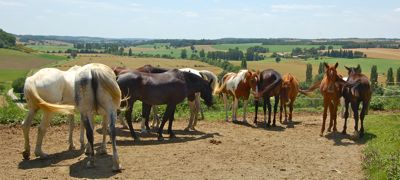| Back to Back Issues Page |
 |
|
The Whole Horse newsletter, Issue #018-- A New Insight Into Balance September 28, 2012 |
A New Insight Into BalanceSpotlight On Training Recently I saw a documentary on our earliest human ancestors and how they survived and evolved to become one of the most successful species the planet Earth has seen. A fascinating connection stuck me between the physical advantage that clinched our success millennia ago, and what we are seeking when we train a horse. I realized that this could explain the deep fulfillment we experience when we achieve gymnastic unity with a horse, and offer a more profound understanding of the origins of dressage. 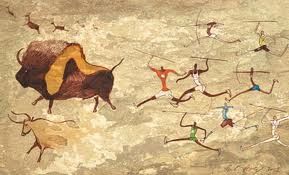 In the harsh environment that our human ancestors lived in, where predators more fierce and powerful than them were numerous, it is not immediately obvious why early humans were able to survive and proliferate as they did. However we now understand that a unique method of hunting was fundamental to our success as a species. Whereas most other predators relied on their physical strength, speed and ferocity, the first humans had a different quality: endurance. In a phenomenal display of perseverance and stamina, hunters would pursue prey animals such as antelope for incredible distances until the animal literally dropped down of exhaustion. This way of hunting is still practiced today by certain African tribes who are direct descendants of our earliest relatives.
In the harsh environment that our human ancestors lived in, where predators more fierce and powerful than them were numerous, it is not immediately obvious why early humans were able to survive and proliferate as they did. However we now understand that a unique method of hunting was fundamental to our success as a species. Whereas most other predators relied on their physical strength, speed and ferocity, the first humans had a different quality: endurance. In a phenomenal display of perseverance and stamina, hunters would pursue prey animals such as antelope for incredible distances until the animal literally dropped down of exhaustion. This way of hunting is still practiced today by certain African tribes who are direct descendants of our earliest relatives.
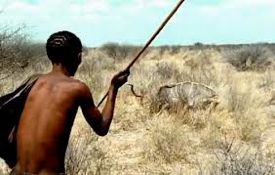 Factors such as our ability to track an animal that is out of sight, and to fabricate tools for the final kill were essential to this hunting method, but what made the human able to outrun a bigger, faster four-legged animal? It all comes down to balance. There are other features that also help, such as our lack of body hair which permitted humans to cool down in the African heat more easily compared to, for example, a hairy antelope, but the balance factor is fundamental.
Factors such as our ability to track an animal that is out of sight, and to fabricate tools for the final kill were essential to this hunting method, but what made the human able to outrun a bigger, faster four-legged animal? It all comes down to balance. There are other features that also help, such as our lack of body hair which permitted humans to cool down in the African heat more easily compared to, for example, a hairy antelope, but the balance factor is fundamental. 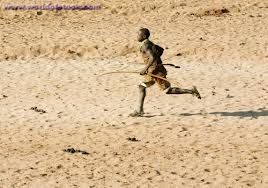
Certain features of human physiology lend us to a very balanced way of running, and this balance permits endurance and stamina over long distances. These features include a very long length of leg relative to the rest of our body, the fact that we run upright on two legs, and the important size, relative to our body, of our gluteus maximus - the buttock muscle - which is one of the strongest muscles in the human body, and acts as a stabilizer to our movement. In fact it was this last feature that made me think of the connection with training horses, because in a very similar way dressage (real dressage, that is!) builds up the horse's haunch muscles in order to stabilize and balance his movement. It is the same lack of balance in movement that makes an antelope wear itself out when chased over a long distance that we are also seeking to address in dressage, where we refer to the horse's natural imbalance as 'being on the forehand'. As this balanced way of moving was essential to our early survival as a species, it occured to me that we humans must be 'programmed' to be particularly sensitive to balance. Indeed many of our sports and recreational activities involve the challenge of balancing in adverse conditions e.g. skiing, surfing, or more 'subtle' forms of balancing such as developing a good golf swing or other skillful ways of hitting a ball. Dressage is perhaps unique in its balance challenge, however, because it involves re-balancing another animal by means of the balance created and maintained in our own body. To me this is a much more fitting idea of the origin of dressage than the usual military one. After all, if dressage only ever had a purpose in the use of the horse in battle, why is it today a more popular activity than ever, when the cavalry is obsolete? The truth is that for most riders inspired by dressage (excluding, of course, those who pursue the sport for the sake of ribbons and recognition) the endless attraction of learning to ride and train lies in those incomparable moments when we succeed in sharing our balance with the horse, and he gives us his power and athleticism in return.
The Parallels with Management In what way does this idea of sharing one of our evolutionary qualities with the horse reflect on our management of domestic horses? The clearest example is in another of our major attributes as a species that has ensured our survival through the millennia: our capacity to plan and make provision. This is a quality that we must be careful not to take too far with regards to horse management, as it can become for them a much of a limitation as it has become in some ways for humankind itself. 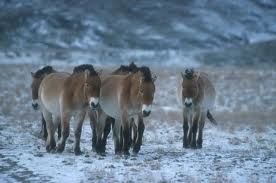 Wild horses in their natural habitat have a wonderful life of freedom and interaction. However, it has to be admitted that they frequently suffer times of great hardship where they can barely find enough food to survive and conditions are incredibly tough. They are prey to many dangers such as predation, lightning, starvation, drought, illness and injury. In wild herds such as those of the Arrowhead or Rocky Mountains in North America, a high percentage of foals especially do not make it through to their first year as a result.
Wild horses in their natural habitat have a wonderful life of freedom and interaction. However, it has to be admitted that they frequently suffer times of great hardship where they can barely find enough food to survive and conditions are incredibly tough. They are prey to many dangers such as predation, lightning, starvation, drought, illness and injury. In wild herds such as those of the Arrowhead or Rocky Mountains in North America, a high percentage of foals especially do not make it through to their first year as a result.
With our domestic horses, protection from danger and provision for their needs is something we can offer to them, in a similar way as we can share our understanding of balance with them. We must be careful that this gift is always based on love, and does not become ruled by fear. In this way we will stay aware of what horses really need, and not let our desire to protect them become a form of abuse. 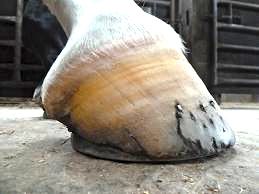
In another example, we may have used our human ingenuity to fabricate metal shoes in order to protect horses' feet, but we overlooked the fact that shoeing interferes with the healthy natural functioning of the hoof and causes profound damage. We must use our capacity to think, and also to feel intuitively, in order to verify that when we provide for the horse's needs, we do so in a holistic way that doesn't sacrifice other needs which may be less obvious to us. Our human preoccupation with planning for the future means that in modern society most of us can live a comfortable life, protected from physical suffering, but it has also meant that many of us have forgotten what it takes to be happy. We are caught in a perpetual search for material success, physical pleasure and security, forgetting that our true peace of mind lies within us.
It is the same for the subject of balance that inspired this newsletter: we have a wonderful capacity to share our awareness of this with the horse, but we must go about it in the right way. 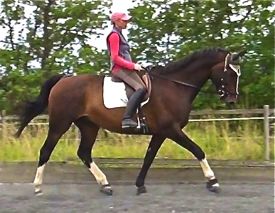 It's is very easy to set about rebalancing the horse with the reins, but in doing so we block his movement and cause him discomfort without actually addressing the source of the imbalance. If we learn how we can rebalance the horse with the correct use of our seat, posture and aiding, then we can channel his movement into balance without sacrificing its freedom and beauty.
It's is very easy to set about rebalancing the horse with the reins, but in doing so we block his movement and cause him discomfort without actually addressing the source of the imbalance. If we learn how we can rebalance the horse with the correct use of our seat, posture and aiding, then we can channel his movement into balance without sacrificing its freedom and beauty.
HHT's monthly Try This At Home Tip To find out whether you are balancing in the right way when you ride, experiment with riding your horse in walk trot and canter on a completely loose rein. Can you engage with his movement through your seat in a consistent and adhesive way? Make sure you are not disconnecting yourself from the movement by leaning forwards and dropping your weight onto the front of your pelvis. Try bringing your upper body back until your weight shifts onto the back of your seat-bones, and feel your lower back stretching with each stride instead of compressing. In this position you have to use your core muscles much more to support you, and develop the suppleness of your hip joint to allow you to keep your leg back underneath you. However this is the only way of sitting that allows us to truly connect to the horse's mov ement and eventually be able to rebalance it. If you have the opportunity of riding on the lunge on a safe and calm horse, without holding the reins, then this is the ideal way to work on your ability to balance with your seat and posture instead of with the rein-contact.
Sharing the Holistic Message
If you enjoy Happy Horse Training and you find the information on the site useful, please help us to share it by clicking on the Facebook 'like' and 'share' buttons (if you have a fb account) that are on each page. Any other way you can pass the site on to friends and colleagues via, for example, discussion forums, is of course also greatly appreciated. You can also sign up to our RSS feed (blog) to be kept up to date with new ideas, pages and other information that we post there. Just click on the box that says 'subscribe to this site' at the right of each page. The equestrian world is one dominated by traditionalist ideas and conventions, but we like to think we can help inform the growing minority of horse-owners who want to make their horses happier with progressive and holistic methods. Happy Horse Training now has over 100 pages exploring many different areas of holistic equitation. Do have a look through our site plan to find the subjects and categories that interest you. Now Available from HHT: 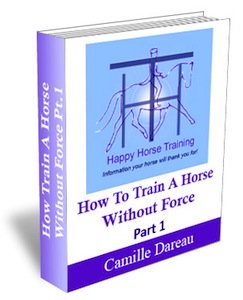 The first part in HHT's Training series: How To Train A Horse Without Force. This quality e-book gives you a unique holistic understanding of training horses, from the very first contact with a young horse, through to a thoroughly explained method of lunging that is beneficial for any horse, not just in preparation for first riding, but at any stage of training.
The first part in HHT's Training series: How To Train A Horse Without Force. This quality e-book gives you a unique holistic understanding of training horses, from the very first contact with a young horse, through to a thoroughly explained method of lunging that is beneficial for any horse, not just in preparation for first riding, but at any stage of training.
With your purchase you will receive a free bonus supplement on Horse Trauma - cutting edge insights on this subject that up until now have mostly been applied only to human trauma. This supplement shows how to recognise, avoid and deal with horse trauma, which is much more common that we realise. These two e-books, comprising more than 75 thousand words and richly illustrated, are available for only 19.99 Euros (around $26). Click here for more details.
|
| Back to Back Issues Page |
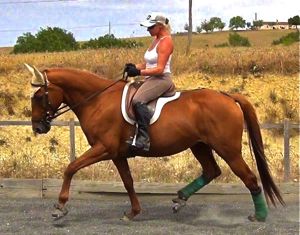 This is the real beauty of dressage - when horse and rider become unified through the phenomenon of
This is the real beauty of dressage - when horse and rider become unified through the phenomenon of 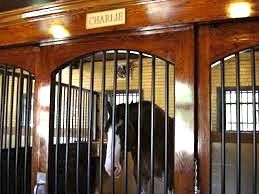 For example, many homeowners feel that the safest place for a horse to be is in a stable: here he is unlikely to injure himself, has sufficient food and water available, and is protected from harsh weather conditions. However this is a complete disregard of other more important needs a horse has, such as the need for freedom of movement, social interaction, and the security of the herd.
For example, many homeowners feel that the safest place for a horse to be is in a stable: here he is unlikely to injure himself, has sufficient food and water available, and is protected from harsh weather conditions. However this is a complete disregard of other more important needs a horse has, such as the need for freedom of movement, social interaction, and the security of the herd.
